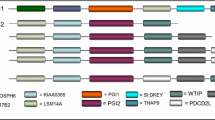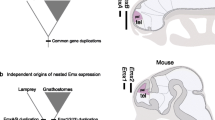Abstract
Numerous vertebrates have four α-1,3/4-fucosyltransferase genes (FUT9, FUT7, FUT4, and FUT Lewis) belonging to the same family. Until now, studies on the evolution of this family have mainly focused on Lewis genes but how the other α-1,3/4-fucosyltransferases have emerged from a common ancestor is not well known. In order to define the respective roles of duplications and mutations, we have compared amino acid sequences representative of bony fish (Takifugu rubripes), amphibians (Xenopus laevis), birds (Gallus gallus), and mammals (Bos taurus). The FUT tree has two fundamental branches, each split into two subfamilies. We found evidence for two duplication events, dated around 710–760 Myr and 590–640 Myr, respectively, compatible with the hypothesis of two rounds of whole genome duplications in chordate genomes, before the emergence of bony vertebrates. Based on the Homo sapiens (human) physical map, we identified blocks of paralogues belonging to regions of FUT9 (6q16), FUT4 (11q21), FUT7 (9q34), and FUT Lewis (19p13) and to a region on HSA1p that is devoid of any FUT. In zebrafish (Danio rerio), an orthologue region of HSA1 harbors an FUT9 specific to bony fish, showing that duplications are not restricted to a single FUT gene but involve blocks of paralogues. In addition, sets of genes within each block clarify the order of duplication events and, as a result, the order of α-1,3/4-fucosyltransferase gene emergence. We have also determined the mutation rates and the density of amino acid changes along protein sequences in each α-1,3/4-fucosyltransferase subfamily during the main vertebrate transitions. After the emergence of tetrapods, the mutation rate of FUT9 decreased dramatically, suggesting the early acquisition of a crucial fucosyltransferase activity in the first stages of development. The FUT7 mutation rate, which in tetrapod ancestors is about half that in amniote ancestors, may be related to the role of this gene in immune systems. In contrast to other subfamilies, we found a constant mutation rate in FUT Lewis and a rather homogeneous amino acid density change, independently of the vertebrate transition, suggesting that hitherto Lewis epitopes have dispensable functions.







Similar content being viewed by others
References
Abi-Rached L, Gilles A, Shiina T, Inoko H (2002) Evidence of en bloc duplication in vertebrate genomes. Nature Genet 31:100–105
Amores A, Force A, Yan YL, Joly L, Amemiya C, Fritz A, Ho RK, Langeland J, Prince VE, Wang YL, Westerfield M, Ekker M, Postlethwait JH (1998) Zebrafish hox clusters and vertebrate genome evolution. Science 282:1711–1714
Bengston P., Larson C, Lundblad A, Larson G, Pahlson P (2001) Identification of a missense mutation (G329, Arg110Gln) in the human FUT7 gene. J Biol Chem 276:31575–31582
Bisbee CA, Baker MA, Wilson AC, Haji-Azimi I, Fischberg M (1977) Albumin phylogeny for clawed frogs (Xenopus). Science 195:785–787
Cailleau-Thomas A, Coullin P, Candelier JJ, Balanzino L, Mennesson B, Oriol R, Mollicone R (2000) FUT4 and FUT9 genes are expressed early in human embryogenesis. Glycobiology 10:789–802
Christoffels A, Koh EGL, Chia JM, Brenner S, Aparicio S, Venkatesh B (2004) Fugu genome analysis provides evidence for a whole-genome duplication early during the evolution of ray-finned fishes. Mol Biol Evol 21:1146–1151
Coates MI (1996) The Devonian tetrapod Acanthostega gunnari Jarvik: postcranial anatomy, basal tetrapod interrelationships and patterns of skeletal evolution. Trans Royal Soc Edinb Earth Sci 87:363–421
Coullin P, Crooijmans RP, Fillon V, Mollicone R, Groenen MA, Adrien-Dehais C, Bernheim A, Zoorob R, Oriol R, Candelier JJ (2003) Cytogenetics, conserved synteny and evolution of chicken fucosyltransferase genes compared to human. Cytogenet Genome Res 103:111–121
Dupuy F, Petit JM, Mollicone R, Oriol R, Julien R, Maftah A (1999) A single amino acid in the hypervariable stem domain of vertebrate α1,3/1,4-fucosyltransferases determines the type 1/type 2 transfer. Characterization of acceptor substrate specificity of the Lewis enzyme by site-directed mutagenesis. J Biol Chem 274:12257–12262
Dupuy F, Germot A, Marenda M, Oriol R, Blancher A, Julien R, Maftah A (2002) Alpha1,4-fucosyltransferase activity: a significant function in the primate lineage has appeared twice independently. Mol Biol Evol 19:815–824
Dupuy F, Germot A, Julien R, Maftah A (2004) Structure/function study of Lewis alpha3- and alpha3/4-fucosyltransferases: the alpha1,4 fucosylation requires an aromatic residue in the acceptor-binding domain. Glycobiology 14:347–356
Endo T, Imanashi T, Gojobori T, Inoka H (1997) Evolutionary significance of intra-genome duplications on human chromosomes. Gene 205:19–27
Felsenstein JP (2002) PHYLIP (phylogeny inference package) version 3.6. Department of Genetics, University of Washington, Seattle (available at: http://evolution.genetics.washington.edu/phylip.html)
Force A, Lynch M, Pickett FB, Amores A, Yan YL, Postlethwait JH (1999) Preservation of duplicate genes by complementary, degenerative mutations. Genetics 151:1531–1545
Grimwood J, Gordon LA, Olsen A, et al. (2004) The DNA sequence and biology of human chromosome 19. Nature 428:529–535
Gu X (1999) Statistical methods for testing functional divergence after gene duplication. Mol Biol Evol 16:1664–1674
Gu X, Vander Velden K (2001) Diverge version 1.04. Programs and documentation (available at: http://xgu1.zool.iastate.edu)
Gu X, Wang Y, Gu J (2002) Age-distribution of human gene families showing equal roles of large and small-scale duplications in vertebrate evolution. Nature Genet 31:205–209
Guérardel Y, Petit D, Madigou T, Guillet B, Maes E, Maftah A, Boujard D, Strecker G, Kol O (2003) Identification of the blood group Lewis a determinant in the oviducal mucins of Xenopus tropicalis. FEBS Lett 554:330–336
Haubold B, Wiehe T (2001) Statistics of divergence times. Mol Biol Evol 18:1157–1160
Hokamp K, McLysaght A, Wolfe KH (2003) The 2R hypothesis and the human genome sequence. J Struct Funct Genomics 3:95–110
Hughes AL (1998) Phylogenetic tests of the hypothesis of block duplication of homologous genes on human chromosomes 6, 9 and 1. Mol Biol Evol 15:854–870
Hughes AL (1999) Phylogenies of developmentally important proteins do not support the hypothesis of two rounds of genome duplication early in vertebrate history. J Mol Evol 48:565–576
Hughes AL, Friedman R (2003) 2R or not 2R: testing hypotheses of genome duplication in early vertebrates. J Struct Funct Genomics 3:85–93
Jaillon O, Aury JM, Brunet F, et al. (2004) Genome duplication in the teleost fish Tetraodon nigroviridis reveals the early vertebrate proto-caryotype. Nature 431:946–957
Javaud C, Dupuy F, Maftah A, Julien R, Petit JM (2003) The fucosyltransferase gene family: an amazing summary of the underlying mechanisms of gene evolution. Genetica 118:157–170
Kageyama N, Natsuka S, Hase S (1999) Molecular cloning and characterization of two zebrafish α (1,3)fucosyltransferase genes developmentally regulated in embryogenesis. J Biochem (Tokyo) 125:838–845
Kaneko M, Kudo T, Iwasaki H, Ikehara Y, Nishihara S, Nakagawa S, Shiina T, Inoko H, Saitou N Narimatsu H (1999) Alpha1,3-fucosyltransferase IX (Fuct-IX) is very highly conserved between human and mouse: molecular cloning, characterization and tissue distribution of human Fuc-TIX. FEBS Lett 452:237–242
Kasahara M (1997) New insights into the genomic organization and origin of the major histocompatibility complex: role of chromosoma (genome) duplication in the emergence of the adaptive immune system. Hereditas 127:59–65
Kumar S, Hedges SB (1998) A molecular timescale for vertebrate evolution. Nature 392:917–920
Kumar S, Tamura K, Nei M (2004) MEGA3: Integrated software for Molecular Evolutionary Genetics Analysis and sequence alignment. Brief Bioinform 5:131–149
Laurin M, Reisz RR, Girondot M (2000) Caecilian viviparity and amniote origins:a reply to Wilkinson and Nussbaum. J Nat Hist 34:311–315
Li WH (1983) Evolution of duplicated genes. In: Nei M, Koehn RK (eds) Evolution of genes and proteins. Sinauer Associates, Sunderland, MA, pp 14–37
Lynch M (2002) Genomics. Gene duplication and evolution. Science 297:945–947
McCurley RS, Recinos A, Olsen AS, Gingrich JC, Szczepaniak D, Cameron HS, Krauss R, Weston BW (1995) Physical maps of human α (1,4) fucosyltransferase genes FUT3-FUT6 on chromosomes 19p13.3 and 11q21. Genomics 26:142–146
McLysaght A, Hokamp K, Wolfe KH (2002) Extensive genomic duplication during early chordate evolution. Nature Genet 31:200–204
Meyer A, Schartl M (1999) Gene and genome duplications in vertebrates: the one-to-four (-to-eight in fish) rule and the evolution of novel gene functions. Curr Opin Cell Biol 11:699–704
Morgenstern B (1999) DIALIGN 2: improvement of the segment-to-segment approach to multiple sequence alignment. Bioinformatics 15:211–218 (available at: http://bibiserv.techfak.uni-bielefeld.de/dialign/)
Niemalä R, Natunen J, Mahuri ML, Maaheimo H, Helin J, Lowe JB, Renkonen O, Renkonen R (1998) Complementary acceptor and site specificities of Fuc-TIV and Fuc-TVII allow effective biosynthesis of sialyl-triLex and related polylactosamines present on glycoprotein counterreceptors of selectins. J Biol Chem 273:4021–4026
Ohno S (1970) Evolution by gene duplication, Springer, Berlin
Oriol R, Mollicone R, Cailleau A, Balanzino L, Breton C (2001) Divergent evolution of fucosyltransferase genes from vertebrates, invertebrates, and bacteria. Glycobiology 9:323–334
Page R (2001) Treeview; available at: http://taxonomy.zoology.gla.ac.uk/rod/rod.html
Panopoulou G, Hennig S, Groth D, Krause A, Potska AJ, Herwig R, Vingron M, Lehrach H (2003) New evidence for genome-wide duplications at the origin of Vertebrates using an Amphioxus gene set and completed animal genomes. Genome Res 13:1056–1066
Piveteau J, Lehman JP, Dechaseaux C (1978) Précis de paléontologie des Vertébrés. Masson, Paris,
Postlethwait JH, Woods IG, Ngo-Hazelett P, Yan YL, Kelly PD, Chu F, Huang H, Hill-Force A, Talbot WS (2000) Zebrafish comparative genomics and the origins of vertebrate chromosomes. Genome Res 10:1890–1902
Prince VE (2002) The hox paradox: more complex(es) than imagined. Dev Biol 249:1–15
Robinson-Rechavi M, Boussau B, Laudet V (2004) Phylogenetic dating and characterization of gene duplications in Vertebrates: the cartilaginous fish reference. Mol Biol Evol 21:580–586
Roos C, Kolmer M, Mattila P, Renkonen R (2002) Composition of Drosophila melanogaster proteome involved in fucosylated glycan metabolism. J Biol Chem 277:3168–3175
Sanderson MJ (2002) Estimating absolute rates of molecular evolution and divergence times: a penalized likelihood approach. Mol Biol Evol 19:101–109
Sanderson MJ (2004) r8s, version 1.70. User’s manual and software (available at: http://ginger.ucdavis.edu/ r8s/index.html)
Sanger F, Nicklen S, Coulson AR (1977) DNA sequencing with chain-terminating inhibitors. Proc Natl Acad Sci USA 74:5463–5467
Smith J, Paton IR, Murray F, Crooijmans RP, Groenen MA, Burt DW (2002) Comparative mapping of human chromosome 10 with the chicken shows conserved synteny and gives an insight into chromosomal evolution. Mammal Genome 13:310–315
Spring J (1997) Vertebrate evolution by interspecific hybridization—Are we polyploid? FEBS Lett 400:2–8
Takezaki N, Rzhetsky A, Nei M (1995) Phylogenetic test of the molecular clock and linearized trees. Mol Biol Evol 12:823–333
Taylor JS, Van de Peer Y, Braasch I, Meyer A (2001) Comparative genomics provides evidence for an ancient genome duplication event in fish. Phil Trans R Soc Lond B 356:1661–1679
Toivonen S, Nishihara S, Narimatsu H, Renkonen O, Renkonen R (2002) Fuc-TIX: a versatile α1,3-fucosuyltransferase with distinct acceptor- and site-specificity profile. Glycobiology 12:361–368
Vandepoele K, De Vos W, Taylor JS, Meyer A, Van de Peer Y (2004) Major events in the genome evolution of vertebrates: paranome age and size differ considerably between ray-finned fishes and land vertebrates. Proc Natl Acad Sci USA 101:1638–1643
Wang Y, Gu X (2000) Evolutionary patterns of the gene families generated in the early stage of vertebrates. J Mol Evol 51:88–96
Wang Y, Gu X (2001) Functional divergence in the caspase gene family and altered functional constraints:statistical analysis and prediction. Genetics 158:1311–1320
Wei-Ping Y, Brenner S, Venkatesh B (2003) Duplication, degeneration and subfunctionalization of the nested synapsin–Timp genes in Fugu. Trends Genet 19:180–183
Weninger W, Ulfman LH, Cheng G, Souchkova N, Quackenbush E, Lowe JB, von Andrian UH (2000) Specialized contributions by α (1,3)-fucosyltransferase-IV and Fuc-T-VII during leucocyte rolling in dermal microvessels. Immunity 12:665–676
Wierinckx A, Mercier D, Oulmouden A, Petit JM, Julien R (1999) Complete genomic organization of futb encoding a bovine α3-fucosyltransferase: exons in human orthologous genes emerged from ancestral intronic sequences. Mol Biol Evol 16:1535–1547
Zhu M, Yu X, Ahlberg PE (2001) A primitive sarcopterygian fish with an eyestalk. Nature 410:81–84
Ackowledgments
This work was supported by grants from the Conseil Regional du Limousin. Thanks are due to Dr. Naoko Takezaki for his help in running the Lintree program. We thank Pr. Véronique Blanquet for helpful comments.
Author information
Authors and Affiliations
Corresponding author
Additional information
[Reviewing Editor: Dr. Gail Simmons]
Rights and permissions
About this article
Cite this article
Petit, D., Maftah, A., Julien, R. et al. En Bloc Duplications, Mutation Rates, and Densities of Amino Acid Changes Clarify the Evolution of Vertebrate α-1,3/4-Fucosyltransferases. J Mol Evol 63, 353–364 (2006). https://doi.org/10.1007/s00239-005-0189-x
Received:
Accepted:
Published:
Issue Date:
DOI: https://doi.org/10.1007/s00239-005-0189-x




